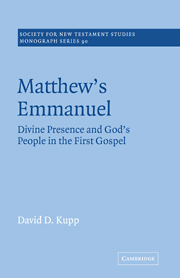Book contents
- Frontmatter
- Contents
- Preface
- List of abbreviations
- 1 Introduction
- 2 Matthew's narrative art
- 3 Reading Matthew's story of divine presence
- 4 Paradigms of presence in the Old Testament
- 5 ‘I am with you’: the Old Testament tradition of the saying
- 6 Matthew 1: the birth of the ‘God-with-us’ Messiah
- 7 Matthew 18.1–20: the presence of Jesus and his έκκλησία
- 8 Matthew 28.16–20: the presence of the risen Jesus
- 9 Jesus' presence and Matthew's christology
- 10 Conclusion
- Bibliography
- Index of passages
- Index of authors
2 - Matthew's narrative art
Published online by Cambridge University Press: 19 January 2010
- Frontmatter
- Contents
- Preface
- List of abbreviations
- 1 Introduction
- 2 Matthew's narrative art
- 3 Reading Matthew's story of divine presence
- 4 Paradigms of presence in the Old Testament
- 5 ‘I am with you’: the Old Testament tradition of the saying
- 6 Matthew 1: the birth of the ‘God-with-us’ Messiah
- 7 Matthew 18.1–20: the presence of Jesus and his έκκλησία
- 8 Matthew 28.16–20: the presence of the risen Jesus
- 9 Jesus' presence and Matthew's christology
- 10 Conclusion
- Bibliography
- Index of passages
- Index of authors
Summary
A text has no life of its own. It ‘lives’ only as an electric wire is alive. Its power originates elsewhere: in a human author. There is another point of comparison: however powerful the author's act of creation, the text lies impotent until it also comes into contact with a human reader.
…those at the receiving end are in control. It is they who decide what to do with the powerful resource they possess – whether and how to use it. They have all the power in their hands.
The aim of this chapter is to assess briefly the role of narrative criticism, in order to ask how the motif of presence is expressed through Matthew's rhetoric. Such an exercise involves swapping a traditional focus on the evangelist's theology for a new focus on story, and the elements thereof.
Method and premises
As Stephen Moore has recently explained, narrative criticism, especially as conceived of and increasingly practised by gospel critics, is above all preoccupied with the evangelist's story, particularly in terms of plot and character. Plot has long been defined as a set of events connected by both temporal succession and causality: ‘The king died and then the queen died of grief’ is a plot; ‘The king died and then the queen died’ is not. Our acts of reading are driven by a powerfully innate desire to supply causal links even where they are not explicit (e.g., in the case of ‘The king died and then the queen died’ the reader naturally tends to assume that the queen's death had something to do with the king's).
- Type
- Chapter
- Information
- Matthew's EmmanuelDivine Presence and God's People in the First Gospel, pp. 28 - 48Publisher: Cambridge University PressPrint publication year: 1996



